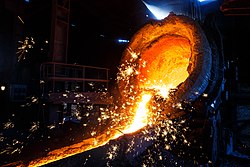
Back فولاذ الأدوات Arabic Alatni čelik BS Nástrojová ocel Czech Værktøjsstål Danish Werkzeugstahl German Acero para herramientas Spanish فولاد ابزاری Persian Työkaluteräkset Finnish Acier à outils French פלדת כלים HE
This article needs additional citations for verification. (August 2009) |

| Steels |
|---|
 |
| Phases |
| Microstructures |
| Classes |
| Other iron-based materials |
Tool steel is any of various carbon steels and alloy steels that are particularly well-suited to be made into tools and tooling, including cutting tools, dies, hand tools, knives, and others. Their suitability comes from their distinctive hardness, resistance to abrasion and deformation, and their ability to hold a cutting edge at elevated temperatures. As a result, tool steels are suited for use in the shaping of other materials, as for example in cutting, machining, stamping, or forging.
Tool steels have a carbon content between 0.5% and 1.5%. The presence of carbides in their matrix plays the dominant role in the qualities of tool steel. The four major alloying elements that form carbides in tool steel are: tungsten, chromium, vanadium and molybdenum. The rate of dissolution of the different carbides into the austenite form of the iron determines the high-temperature performance of steel (slower is better, making for a heat-resistant steel). Proper heat treatment of these steels is important for adequate performance.[1] The manganese content is often kept low to minimize the possibility of cracking during water quenching.
There are six groups of tool steels: water-hardening, cold-work, shock-resistant, high-speed, hot-work, and special purpose. The choice of group to select depends on cost, working temperature, required surface hardness, strength, shock resistance, and toughness requirements.[2] The more severe the service condition (higher temperature, abrasiveness, corrosiveness, loading), the higher the alloy content and consequent amount of carbides required for the tool steel.
Tool steels are used for cutting, pressing, extruding, and coining of metals and other materials. Their use in tooling is essential; injection molds for example require tool steels for their resistance to abrasion- an important criterion for mold durability which enables hundreds of thousands of moldings operations over its lifetime.
The AISI-SAE grades of tool steel is the most common scale used to identify various grades of tool steel. Individual alloys within a grade are given a number; for example: A2, O1, etc.
- ^ Verhoeven, John (2007). Steel Metallurgy for the Non-Metallurgist. ASM International. p. 159. ISBN 978-0-87170-858-8. Retrieved 9 November 2014..
- ^ Baumeister, Avallone, Baumeister (1978). "6". Marks' Standard Handbook for Mechanical Engineers, 8th ed. McGraw Hill. pp. 33, 34. ISBN 9780070041233.
{{cite book}}: CS1 maint: multiple names: authors list (link)
© MMXXIII Rich X Search. We shall prevail. All rights reserved. Rich X Search